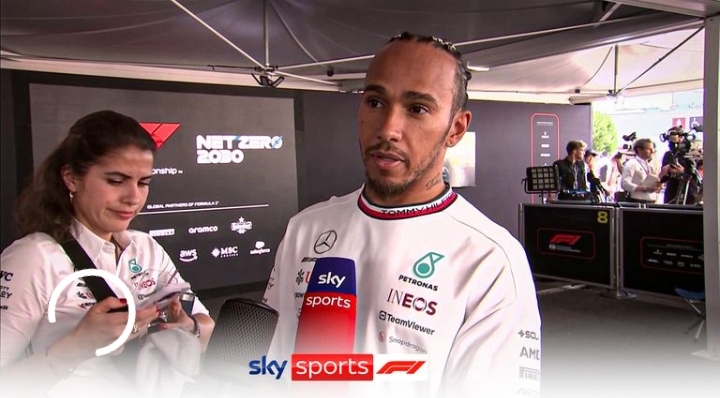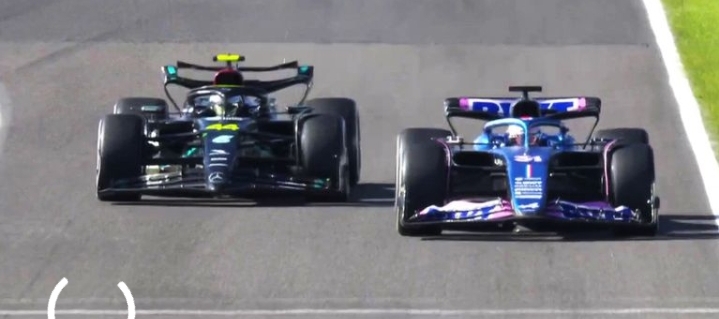Lewis Hamilton and George Russell Explain dramatic Japanese GP for Mercedes as pair come close to contact at Suzuka.

Lewis Hamilton and George Russell came close to contact twice during the first part of the Japanese GP on Sunday; the pair also had differing views on tactics on the radio at the end of the race; watch all sessions at the Qatar GP on Sky Sports F1 from October 6-8.
Lewis Hamilton says he felt “exhausted” after a rollercoaster race which saw him nearly collide with Mercedes team-mate George Russell on two occasions and suggested they should have been switched around earlier when the pair found each other again near the end of the Japanese Grand Prix.
Hamilton and Russell swapped places after the safety car restart, with the seven-time world champion leaning slightly to the right during his quick run into Turn 1.
On lap 16, Hamilton ran wide to second Degner, allowing Russell to follow him entering Spoon Curve into turn 13. However, Hamilton was ahead of his teammate, so Russell wondered “are- we What’s the point of fighting the other person?” or others?”
To begin with, I was already exhausted. I’m fighting with everything I have to get as high as possible and get ahead of Ferrari, who have had an upgrade this week and are exceptionally fast,” Hamilton told Sky Sports F1.
They have been faster in the last three races. It was a pretty big fight. I scored the most points for the team, I was really trying to hold on to second place for the builder title because I really knew how important it was to everyone in the factory.
“So you definitely have to give everything, but it’s difficult on weekends like this, especially when the car is very difficult. It’s basically exactly the same as last year, so stay feel level, the car feels exactly the same as last year, bouncing and sliding. So it’s difficult to progress all the work we’ve done and we’re not closer to the front, at least at This. “But we got ahead of one of the Ferraris, it was great team spirit and great work from the guys at the stops and being strategic. There’s a long way to go.”
Mercedes explains the Russell-Hamilton swap
The other dramatic moment came with five laps remaining when Hamilton found himself stuck behind Russell, who was trying to hold on to fifth place with a daring one-stop strategy.
Russell wanted to partner Hamilton by keeping him in his DRS, rather than letting him pass, so that both drivers could get ahead of the charging Carlos Sainz. Coincidentally, Sainz had used DRS strategy to win the Singapore Grand Prix a week earlier.

Instead, Russell let Hamilton pass but was then also passed by Sainz and finished seventh. On the radio, a frustrated Russell said:
“If you want to play the team game… he pushed me off the track before,” referring to the incident with Hamilton earlier in the Grand Prix.
“When you’re in the car and doing 48 laps, you’re trying your best and coming up with a suboptimal strategy to try to work. This radio is a way to relieve some of the frustration ,” Russell said.
Lewis Hamilton and George Russell collided for the second time in the race before turn 11 at Suzuka.
“Overtaking is very difficult. You saw Piastri with much newer tires and a much faster car this weekend, he didn’t miss. It took him two turns.
“For me, the aim is to secure P2 among the constructors. Personally, the drivers’ championship is completely out of reach. It’s been an absolutely disastrous season, very much missed opportunity. Lewis is in a very good position .position of P3. Standing here now, everything is fine.”
Hamilton disagreed with Russell’s motive for using the DRS train to try to get both Mercedes to the finish line ahead of Sainz.
“We should have swapped places sooner and I should have gone as far as possible to reduce the gap to Ferrari as much as possible,” he said. “He (Russell) was trying to hit me, he damaged his tires and I thought those were just complications.

In fact, we weren’t competing for the team championship. As drivers, it doesn’t matter where we are. What mattered was that one of us finished ahead of the Ferrari and maintained his position. Today we really need to work as a team.
“When they suggested it to me, I knew they had obviously been thinking about it since the last race, but it didn’t make any sense. I need to speak as clearly as possible. I was on my way with about two seconds to spare and they told me to give George the DRS and I had to cut the throttle immediately. He was then overtaken by Sainz. Then he passed George and was right behind me, which was not ideal.”
Mercedes Trackside Technical Director Andrew Shovlin added:
“When we decided to change them, we realized how fast Carlos was at the back and Lewis in the middle could also be dangerous on older tyres.
“Maybe it could have worked better, but what we’re trying to protect is that Lewis also lost that position because he was the one most likely to finish ahead of Carlos.”
Why did Russell do a one-stop?
Russell was the only driver to complete the Japanese Grand Prix with a one-stop, which many people thought was not possible before the race.
It didn’t gain the British driver anything in the end and Shovlin admitted Hamilton’s unfortunate contact with Perez at the start, which put the Mercedes pair together on track, was a reason for the differing strategies.
“The way the race panned out from the start with the contact from Perez on Lewis, we lost a position and were on the backfoot. It was always going to be very marginal with making the strategies work and fighting the Ferraris,” he explained.
That’s why we split the strategies, knowing there was a potential for interaction and that we may have to manage that on track.
“They are obviously both racing hard in a car that was tricky – pushing to the limit. There was some radio traffic that reflected that but we got into the habit of not reading too much into what’s said in the heat of the moment and pressure of a cockpit – particularly at a hot and demanding race like this one.






